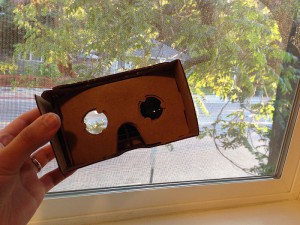Virtual reality has been a hot topic for a long while, but only recently has the technology reached levels of price and accessibility that have made it worth considering for non-gigantic libraries. The phrase “virtual reality” brings to mind clunky glasses strapped to the face and, make no mistake, fully wearable hardware is still a huge part of the virtual reality landscape. Microsoft’s upcoming HoloLens and Oculus Rift’s new headset are good examples of fully-prefabricated VR devices that you affix to your head. They’re also good examples of pretty expensive technology, outside the budget of libraries which are not already committed to large-scale VR projects. But there are affordable alternatives for those who are interested in trying out VR without breaking the bank.
It doesn’t get much more economical than Google’s Cardboard project. Google offers downloadable instructions which will allow you to make your own VR viewer using magnets, Velcro, and cardboard from an old cereal or pizza box. If you’re not inclined to DIY, you can also purchase pre-assembled cardboard or plastic viewers from a vendor. Once you’ve built or bought your Cardboard set, you’ll insert a fairly new and large smartphone into the viewer.
Other manufacturers offer similar budget-friendly tech. Oculus is offering a $99 headset which works with 2015 Samsung phones. Even View-Master has revamped their product into a $30 virtual reality device. Don’t worry, they still use reels. There are plenty of other companies which provide low-cost VR viewers. Potential buyers should remember, however, that many of these devices work in tandem with smartphones, so be sure to budget for both the $30 Google Cardboard set and the $600 cell phone.
So what can you do with this technology? As you might expect, games are a natural fit for virtual reality. The popular game Minecraft is coming for the Oculus Rift and Google’s Play Store has an entire section devoted to VR-friendly apps for Cardboard. But the possibilities extend beyond gaming. The recent Democratic debate on CNN featured a virtual reality broadcast that was apparently rather quirky. And some hotel chains are experimenting with VR devices that allow viewers to travel to far-flung locations. Imagine a program on weather that would allow patrons to step into a hurricane through a VR viewer. Or a program on Italian cooking that ends with a VR tour of Milan. With costs dropping, it’s becoming affordable to experiment, so you might consider finding a place for virtual reality at your library.


